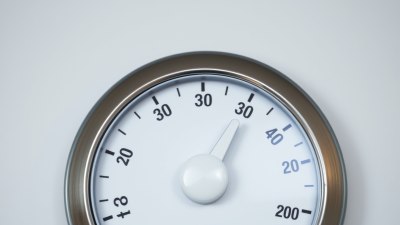The Emotional Thermostat You Didn’t Know You Had
Explore how your emotional thermostat regulates feelings, impacts behavior, and offers techniques to maintain balance for mental well-being.

Image created with Flux Schnell
Have you ever noticed how your mood can shift seemingly on its own, fluctuating between calm and agitation without an obvious cause? Much like a thermostat controls the temperature in your home, your mind has an emotional thermostat that regulates your feelings. This often unconscious mechanism helps maintain a balance of emotions, allowing you to navigate life effectively. Understanding this emotional thermostat can empower you to take control of your mood, improve your mental health, and foster healthier relationships.
Understanding the Emotional Thermostat Concept
The term 'emotional thermostat' refers to an internal psychological system that senses and regulates emotional states, pushing you back to your baseline mood after emotional highs or lows. Just as a thermostat activates heating or cooling to keep a room at a specific temperature, your emotional thermostat activates coping mechanisms to maintain emotional equilibrium.
We all have what's often called a 'set point' of emotional baseline - an average mood level shaped by genetics, personality, life experiences, and current circumstances. When emotions veer too far above or below this baseline, the emotional thermostat engages to bring you back to your default emotional state. For example, if you become overly anxious or euphoric, your mental system will nudge you towards calmness or neutrality over time.
However, just as household thermostats can malfunction or be poorly calibrated, emotional thermostats can sometimes misfire, causing mood swings, persistent negative emotions, or difficulties recovering from emotional stress. Recognizing and tuning this internal system is essential for emotional resilience and psychological health.
How the Emotional Thermostat Develops
This self-regulating emotional system develops early in life through genetic predispositions and environmental influences. For infants, the emotional thermostat is rudimentary but evolves quickly through interactions with caregivers who provide emotional feedback, affection, and reassurance. Secure attachments help set a stable emotional baseline and healthy regulation mechanisms.
Childhood experiences including trauma, neglect, or excessive stress can cause the emotional thermostat to become skewed. For instance, chronic exposure to danger might lower the threshold for anxiety, leading to a hypervigilant emotional setting. Conversely, neglect or emotional suppression might flatten emotional responses, making it harder to access or express feelings.
Throughout adolescence and adulthood, ongoing experiences repeatedly calibrate this emotional system. Supportive relationships, mindfulness practices, therapy, and stress management can help tune the thermostat towards healthier regulation, while toxic relationships, substance abuse, or unresolved trauma may disrupt balance.
Biological Foundations of Emotional Regulation
Your emotional thermostat is rooted deeply in neurobiology. The brain regions involved include the amygdala, which processes emotions like fear and pleasure, and the prefrontal cortex, which helps regulate and control emotional responses. The interaction between these areas forms the basis for emotional regulation.
Neurotransmitters such as serotonin, dopamine, and norepinephrine also influence your emotional set point and flexibility. Imbalances or deficiencies in these chemical messengers can cause mood disorders or emotional instability. For example, serotonin levels are closely linked to mood and anxiety, explaining why selective serotonin reuptake inhibitors (SSRIs) are often used to treat depression.
Furthermore, the hypothalamic-pituitary-adrenal (HPA) axis, which governs the stress response, plays a critical role in emotional regulation. Chronic stress can dysregulate the HPA axis, shifting the emotional thermostat towards heightened anxiety or depression.
The Significance of Emotional Set Points
Your emotional set point, the baseline mood your emotional thermostat tries to maintain, can vary between individuals. Some are naturally more optimistic or cheerful, while others may lean towards melancholy or anxiety. This set point affects how you perceive and respond to life’s events and how quickly you return to equilibrium after emotional disturbances.
Research in positive psychology suggests that while genetics contribute to your emotional baseline—accounting for roughly 50% of your happiness level—your actions, environment, and attitude shape the rest. Practicing gratitude, kindness, and mindfulness can gradually elevate your emotional set point and improve resilience.
Understanding your emotional set point helps you recognize when your mood fluctuations are temporary reactions or a sign that the thermostat requires tuning. For instance, persistent sadness or irritability beyond your usual baseline may indicate depression or anxiety, requiring attention.
Common Signs of a Miscalibrated Emotional Thermostat
If your emotional thermostat malfunctions, you may experience frequent mood swings, inability to return to your baseline after stress, or chronic negative emotions. This can manifest as irritability, overwhelm, anxiety, depressive symptoms, or emotional numbness.
People with mood disorders often have an emotional thermostat that struggles to maintain balance. Bipolar disorder involves extreme oscillations between emotional highs and lows. Persistent depressive disorder might involve a baseline that is stuck in a low mood state.
Moreover, individuals with post-traumatic stress disorder (PTSD) might have an emotional thermostat locked in hypervigilance or emotional numbness due to trauma. Recognizing these patterns is the first step towards recalibrating emotional regulation.
Techniques to Tune Your Emotional Thermostat
Regulating your internal emotional thermostat is achievable through consistent effort and self-awareness. Here are effective strategies to help stabilize your mood and enhance resilience:
1. Mindfulness Meditation: This practice teaches you to observe emotions without judgment, allowing your emotional thermostat to reset naturally. Regular mindfulness reduces reactivity and strengthens prefrontal cortex activity.
2. Cognitive Behavioral Techniques: Recognizing and challenging negative thought patterns can prevent downward emotional spirals and recalibrate your mood set point.
3. Physical Exercise: Exercise releases endorphins and neurotransmitters that boost mood and promote a balanced emotional state. It also reduces stress hormone levels.
4. Social Connections: Positive relationships provide emotional support and feedback that help moderate your emotional thermostat.
5. Journaling: Writing about feelings can provide insight and release pent-up emotions, allowing your internal system to rebalance.
6. Professional Help: Therapy, counseling, or medication may be necessary if emotional dysregulation is severe or linked to mental health disorders.
The Role of Emotional Awareness
A crucial skill in managing your emotional thermostat is building emotional awareness. This means understanding the nuances of your emotions—their triggers, intensity, duration, and effects on your behavior. Emotional awareness helps you recognize when your internal system is off balance and signals that self-care or intervention is needed.
Techniques such as labeling emotions, practicing deep breathing, or using biofeedback devices can increase awareness. The more attuned you are to your emotions, the better you can prevent extremes and maintain homeostasis.
Impact on Relationships
Your emotional thermostat not only affects your internal state but also has profound influence on your interactions with others. When balanced, you can communicate effectively, empathize, and maintain healthy boundaries. However, a misregulated emotional thermostat can cause conflicts, misunderstandings, and emotional distancing.
People who struggle with emotional regulation may unintentionally project their mood states onto others or respond poorly to stress. Thus, part of tuning your emotional thermostat involves recognizing how your mood affects your relationships and making conscious adjustments.
Emotional Thermostat and Workplace Well-being
Emotional regulation plays a significant role in professional settings. An out-of-balance emotional thermostat can cause burnout, decreased productivity, and poor decision-making. Stress management techniques, breaks, and maintaining work-life balance are crucial to sustaining emotional equilibrium at work.
Organizations that promote emotional intelligence training and supportive environments encourage employees to develop healthier emotional thermostats, leading to better morale and performance.
Future Directions in Emotional Thermostat Research
Scientists are increasingly focusing on the concept of emotional thermostats in understanding mental health and developing therapies. Advances in neuroimaging and psychophysiology allow detailed examination of how the brain regulates emotions. Personalized interventions targeting specific dysfunctions in emotional regulation are becoming more feasible.
Technological innovations such as wearable devices that monitor physiological signals like heart rate variability or skin conductance may provide real-time feedback to users, helping them manually adjust their emotional thermostat before issues escalate.
Everyday Practices for Sustained Emotional Balance
Incorporating simple habits into your daily routine can strengthen your emotional thermostat. These include getting sufficient sleep, maintaining a nutritious diet, limiting alcohol and caffeine intake, engaging in hobbies, and continuous self-reflection. Small, consistent actions accumulate into substantial improvements in your mood regulation capacity.
Remember, emotional balance is not about eliminating all negative feelings but about creating a stable internal environment that allows you to experience emotions fully without being overwhelmed.
The emotional thermostat you didn’t know you had governs your feelings silently but powerfully. By becoming aware of its mechanisms and adopting strategies to maintain its balance, you can foster greater emotional resilience, healthier relationships, and improved overall well-being.











